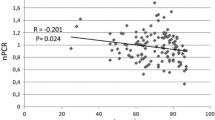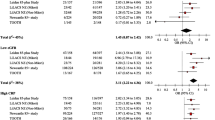Abstract
Objectives
To characterise the risk factors for chronic idiopathic normocytic anaemia (CINA) in older people, particularly the role of age-associated renal impairment.
Methods
Patients aged ≥65 years admitted to a medical unit over 12 months were assessed. Those with secondary causes of anaemia including chronic kidney disease (CKD) were excluded. CINA was defined as a haemoglobin <130 g/l for men and <120 g/l for women for at least 6 months without any apparent cause. Renal function was determined by estimating creatinine clearance (CrCl) using Cockcroft–Gault formula, and glomerular filtration rate (GFR) using modification of diet in renal disease (MDRD) and chronic kidney disease epidemiology collaboration (CKD-EPI) formulas.
Results
116 had CINA. Controls were 572. The mean estimates of renal function were significantly lower in cases as compared with controls (P < 0.001). The risk of CINA increased by 12.6, 10.4 and 12 %, respectively, for each unit decrease in CrCl, MDRD-eGFR and CKD-EPI-eGFR, independent of age and other covariates. The adjusted odds ratios for CINA in those with CrCl, MDRD or CKD-EPI eGFR <60 ml/min/1.73 m2 were 2.68 (CI 1.53–4.70); 2.70 (CI 1.57–4.62) and 2.12 (CI 1.46–3.74), respectively. Other covariates in the model that were independently associated with CINA included advanced age, diabetes mellitus (DM), use of angiotensin converting enzyme inhibitor (ACEI) or angiotensin receptor blocker (ARB), history of dementia and living in a residential care facility.
Conclusions
Age-associated renal impairment independently contributes to CINA. Other potential risk factors for CINA include advanced age, DM and ACEI or ARB use.

Similar content being viewed by others
References
Ania BJ, Suman VJ, Fairbanks VF et al (1997) Incidence of anemia in older people: an epidemiologic study in a well defined population. J Am Geriatr Soc 45:825–831
Nathavitharana RL, Murray JA, D’Sousa N et al (2012) Anaemia is highly prevalent among unselected internal medicine inpatients and is associated with increased mortality, earlier readmission and more prolonged hospital stay: an observational retrospective cohort study. Intern Med J 42:683–691
Artz AS, Thirman MJ (2011) Unexplained anemia predominates despite an intensive evaluation in a racially diverse cohort of older adults from a referral anemia clinic. J of Gerontol A Biol Sci Med Sci 66:925–932
Nilsson-Ehle H, Jagenburg R, Landahl S et al (2000) Blood haemoglobin declines in the elderly: implications for reference intervals from age 70 to 88. Eur J Haematol 65:297–305
Yamada M, Wong FL, Suzuki G et al (2003) Longitudinal trends of haemoglobin levels in a Japanese population—RERF’s adult health study subjects. Eur J Haematol 70:129–135
Rowe JW, Andres R, Tobin JD et al (1976) The effect of age on creatinine clearance in men: a cross-sectional and longitudinal study. J Gerontol 31:155–163
Lindeman RD, Tobin J, Shock NW (1985) Longitudinal studies on the rate of decline in renal function with age. J Am Geriatr Soc 33:278–285
Ferrari P, Xiao J, Ukich A et al (2009) Estimation of glomerular filtration rate: does haemoglobin discriminate ageing and true CKD? Nephrol Dial Transplant 24:1828–1833
Moranne O, Froissart M, Rossert J et al (2009) Timing of onset of CKD-related metabolic complications. J Am Soc Nephrol 20:164–171
World Health Organization (1968) Nutritional anemias: report of a WHO Scientific Group. World Health Organization, Geneva
Sharma SK, Saini N, Chwla Y (2005) Hepatitis B virus: inactive carriers. Virol J 2:82
KDIGO 2012 (2013) Clinical practice guideline for the evaluation and management of chronic kidney disease. Kidney Int Suppl 3:1–150
Rule AD, Gussak HM, Pond GR et al (2004) Measured and estimated GFR in healthy potential kidney donors. Am J Kidney Dis 43:112–119
Wetzels JF, Kiemeney LA, Swinkels DW et al (2007) Age-and gender-specific reference values of estimated GFR in Caucasians: the Nijmegen biomedical study. Kidney Int 72:632–637
Chadban SJ, Briganti EM, Kerr PG et al (2003) Prevalence of kidney damage in Australian adults the AusDiab kidney study. J Am Soc Nephrol 14(7 suppl2):S131–S138
Roderick PJ, Atkins RJ, Smeeth L et al (2008) Detecting chronic kidney disease in older people; what are the implications? Age Ageing 37:179–186
Cockcroft DW, Gault MH (1976) Prediction of creatinine clearance from serum creatinine. Nephron 16:31–41
Levey AS, Coresh J, Greene T et al (2006) Chronic Kidney Disease Epidemiology Collaboration. Using standardized serum creatinine values in the modification of diet in renal disease study equation for estimating glomerular filtration rate. Ann Intern Med 145:247–254
Levey AS, Stevens LA, Schmid CH et al (2009) A new equation to estimate glomerular filtration rate. Ann Intern Med 150:604–612
Astor BC, Muntner P, Levin A et al (2002) Association of kidney function with anemia: the Third National Health and Nutrition Examination Survey (1988–1994). Arch Intern Med 162:1401–1408
Lippi G, Franchini M, Salvagno GL et al (2010) Determinants of anaemia in the very elderly: a major contribution from impaired renal function? Blood Transfus 8:44–48
Cumming RG, Mitchell P, Craig JC et al (2004) Renal impairment and anemia in a population-based study of older people. Int Med J 34:20–23
Ble A, Fink JC, Woodman RC et al (2005) Renal function, erythropoietin, and anemia of older persons: the In Chianti study. Arch Intern Med 165:2222–2227
Hsu CY, McCulloch CE, Curhan GC (2002) Epidemiology of anemia associated with chronic renal insufficiency among adults in the United States: results from the Third National Health and Nutrition Examination Survey. J Am Soc Nephrol 13:504–510
Thomas MC, Cooper ME, Tsalamandris C et al (2005) Anaemia with impaired erythropoietin response in diabetic patients. Arch Intern Med 165:466–469
Bonakdaran S, Gharebaghi M, Vahedian M (2011) Prevalence of anemia in type 2 diabetes and role of renal involvement. Saudi J Kidney Dis Transplant 22:286–290
Macdougall IC (1999) The role of ACE inhibitors and angiotensin II receptor blockers in the response to epoetin. Nephrol Dial Transplant 14:1836–1841
Artz AS (2008) Anaemia and the frail elderly. Semin Hematol 45:261–268
Chaves PHM (2008) Functional outcomes of anaemia in older adults. Semin Hematol 45:255–260
Artz SA, Xue QL, Wickrema A et al (2014) Unexplained anaemia in the elderly is characterised by features of low grade inflammation. Br J Haematol 167:286–289
Delanaye P, Cavalier E, Mariat C et al (2010) MDRD or CKD-EPI study equations for estimating prevalence of stage 3 CKD in epidemiological studies: which difference? Is this difference relevant? BMC Nephrol 11:8
Acknowledgments
The authors thank the clinical coordinators and nursing staff of the General Internal Medicine Unit, Western Health, for their help with this study.
Author information
Authors and Affiliations
Corresponding author
Ethics declarations
Funding
None.
Conflict of interest
On behalf of all authors, the corresponding author states that there is no conflict of interest.
Ethical approval
All procedures performed in studies involving human participants were in accordance with the ethical standards of the institutional and/or national research committee and with the 1964 Helsinki declaration and its later amendments or comparable ethical standards.
Informed consent
Informed consent was obtained from all individual participants included in the study.
Rights and permissions
About this article
Cite this article
Anpalahan, M., Savvas, S., Lo, K.Y. et al. Chronic idiopathic normocytic anaemia in older people: the risk factors and the role of age-associated renal impairment. Aging Clin Exp Res 29, 147–155 (2017). https://doi.org/10.1007/s40520-016-0563-0
Received:
Accepted:
Published:
Issue Date:
DOI: https://doi.org/10.1007/s40520-016-0563-0




